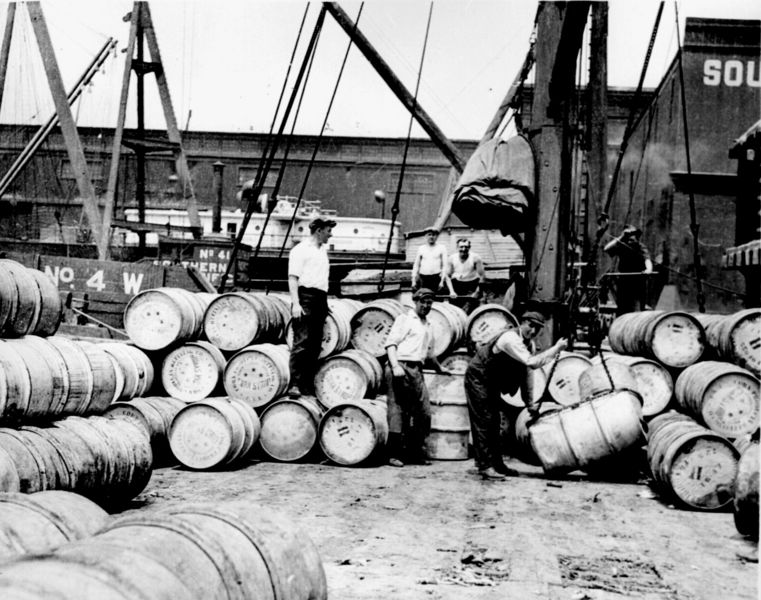|
LADE
(layd)
To
load with cargo
Common
clues: Stevedore;
Fill with cargo; Fill the hold; Put on board; Weigh down; Stow
below; Burden
Crossword
puzzle frequency:
3 times a year
Frequency
in English language:
70807 / 86800
Video:
Wharfies
Loading
and unloading ships requires knowledge of the operation of
loading equipment, the proper techniques for lifting and stowing
cargo, and correct handling of hazardous materials. In addition,
workers must be physically strong and be able to follow orders.

Stevedores
on a New York dock loading barrels of corn syrup onto a barge on
the Hudson River. Photograph by Lewis Hine, ca. 1912
In
earlier days, men who load and unload ships had to tie down
cargoes with rope. A type of stopper knot is called the stevedore
knot. The methods of securely tying up parcels of goods is called
stevedore lashing or stevedore knotting. While loading a general
cargo vessel, they use dunnage, which are pieces of wood (or
nowadays sometimes strong inflatable bags) set down to keep the
cargo out of any water that might be lying in the hold or are
placed as shims between cargo crates to keep them from shifting
during a voyage.
Today,
the vast majority of non-bulk cargo is transported in shipping
containers.[3] The containers arrive at a port by truck, rail or
another ship and are stacked in the port's storage area. When the
ship that will be transporting them arrives, the containers that
it is offloading are unloaded by a crane. The containers either
leave the port by truck or rail or are put in the storage area
until they are put on another ship. Once the ship is offloaded,
the containers it is leaving with are brought to the dock by
truck. A crane lifts the containers from the trucks into the
ship. As the containers pile up in the ship, the workers connect
them to the ship and to each other. The jobs involved include the
crane operators, the workers who connect the containers to the
ship and each other, the truck drivers that transport the
containers from the dock and storage area, the workers who track
the containers in the storage area and as they are loaded and
unloaded, as well as various supervisors. Those workers at the
port who handle and move the containers are likely to be
considered stevedores or longshoremen.
This
article is licensed under the GNU
Free Documentation License.
It uses material from the Wikipedia
article "Stevedore".
LADE
(166)
18 We- >1 08 Fill with cargo
18
Tu >1 05 Take on cargo
14
Tu >1 09 Stow cargo
12
Tu >1 99 Fill the hold
11
We >1 07 Put on board STOW
9
Mo+ >1 08 Put on cargo STOW
6
We >1 00 Put in the hold STOW
6
We- >1 05 Weigh down
4
Tu- >1 08 Fill with freight
4
Th >1 04 Stevedore
4
Tu+ >1 09 Stow, as cargo
3
Fr >1 05 Put on GAIN HIRE LOAD WEAR WORE
3
Fr- >1 03 Stow PACK
3
Fr+ >1 08 Fill a hold
3
Mo+ NYT 04 Put on board, as cargo
3
Th+ LAT 09 Stow below
2
Tu- >1 06 Burden DEBT LOAD NEED ONUS
2
Th- >1 08 Take on DARE HIRE
2
Th- >1 97 Load cargo STOW
2
Fr- >1 99 Put aboard STOW
2
We- LAT 99 Put below STOW
2
Th- >1 98 Load up
2
We- >1 07 Put in a cargo hold
97
Put on freight
4
Th WSJ 07 Home in a 1936 novel
4
Th >1 08 Home of ancient Irish kings
4
We+ >1 09 O'Hara plantation
4
Th- >1 04 Twelve Oaks neighbor
|